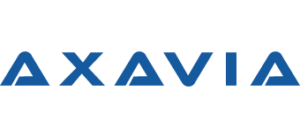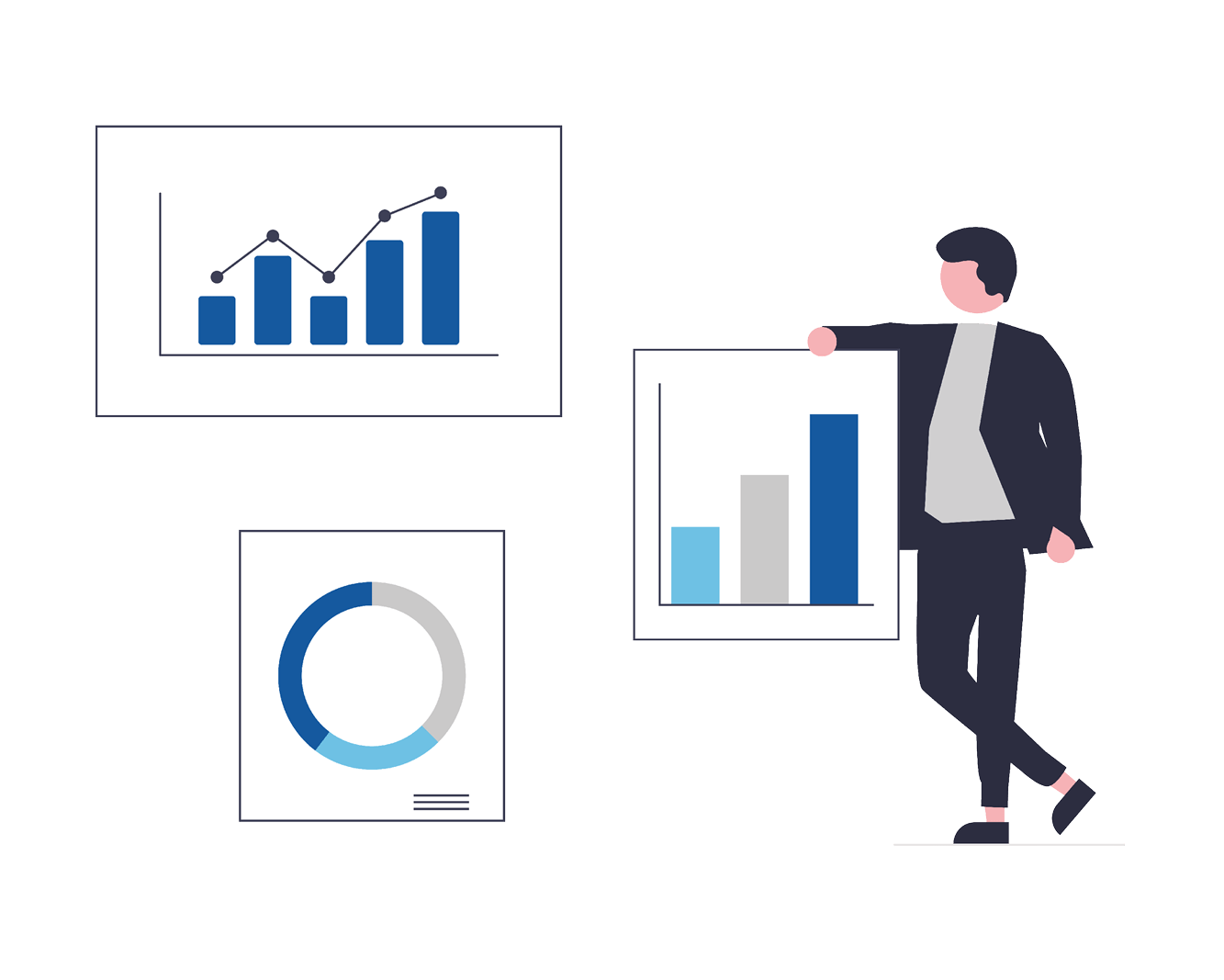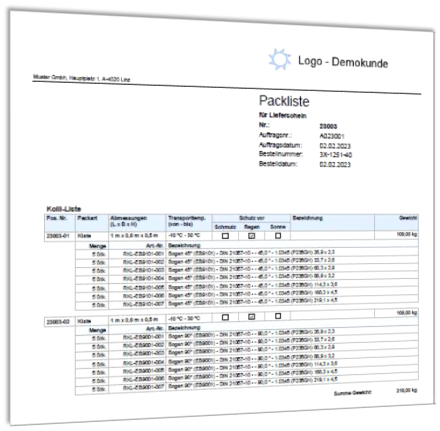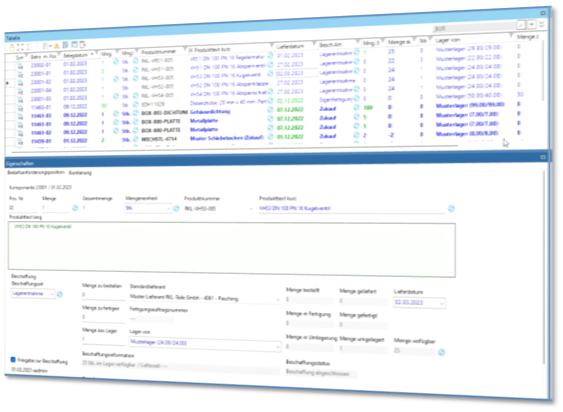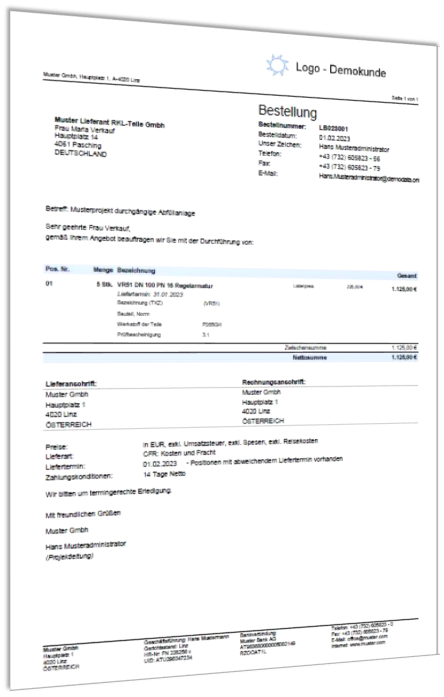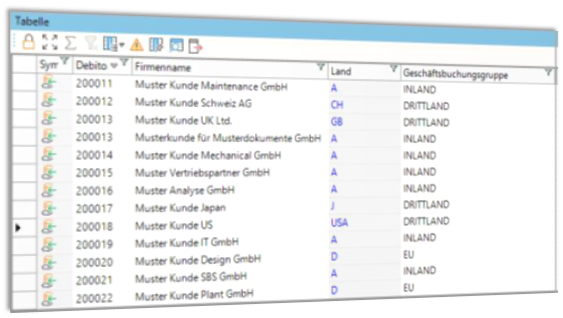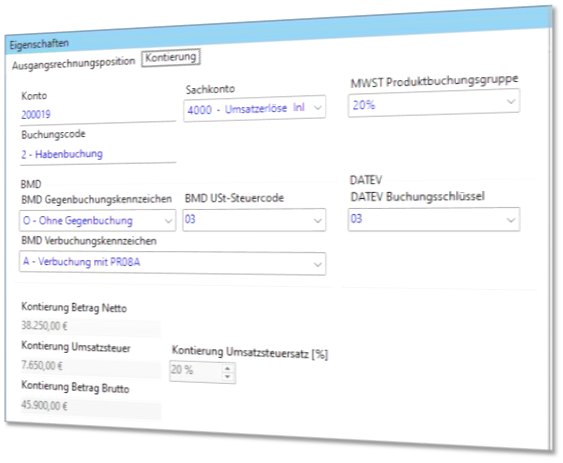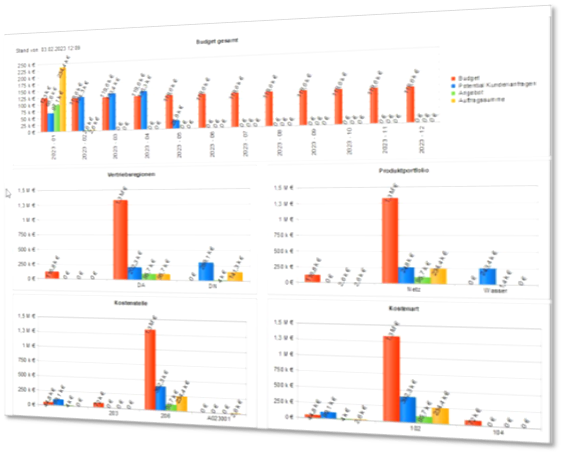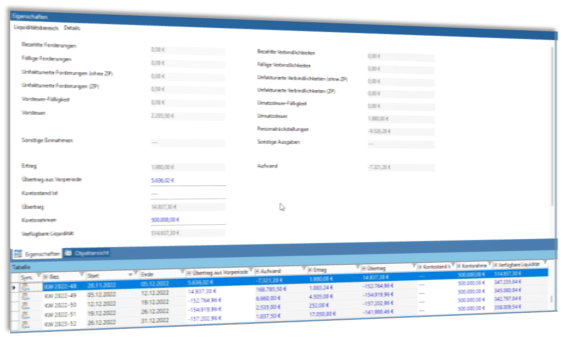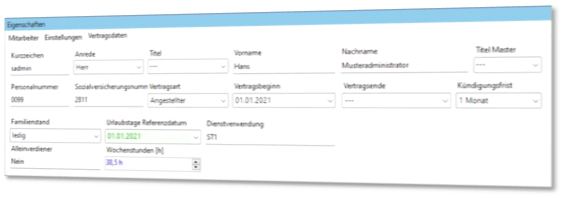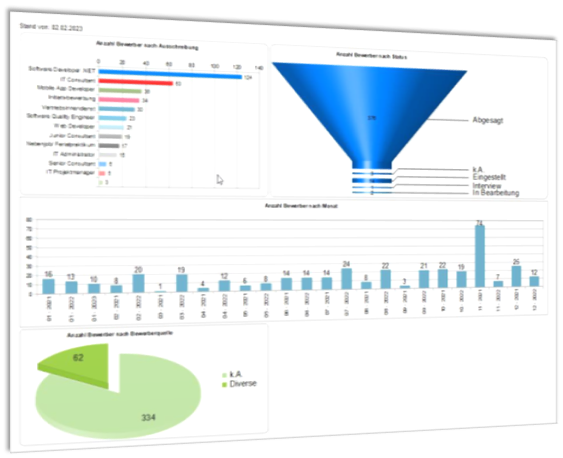Digitization of your order processing and merchandise management
Optimize your business processes and increase the efficiency of your company. Our diverse modules support you in managing your orders, finances, personnel and IT-specific products, among other things. With just a few clicks you can process your orders, create delivery bills and invoices as well as manage partial invoices and advance payments. The financial management offers you a comprehensive overview of your finances and with AXAVIAhrm you digitize the personnel management of your company. In addition, AXAVIA enables you to efficiently manage your IT-specific products. This gives you a holistic solution to increase the efficiency of your business processes and to optimize your company.
Your advantages with AXAVIAerp:
- Optimal support for your complete order processing
- Overview of your finances and interfaces to various accounting programs
- Digitized personnel management processes
- Manage IT-specific products such as software licenses or maintenance contracts
Efficient customer and supplier management
Business partners from the CRM module become customers or suppliers. You can also enter and manage financial institutions for bank guarantees or transport companies separately.
When creating customer or supplier documents, you have quick and easy access to the customer and supplier data.
- Customer database with classification
- Supplier database with rating
- Bank and account management
- All customer and supplier data at a glance
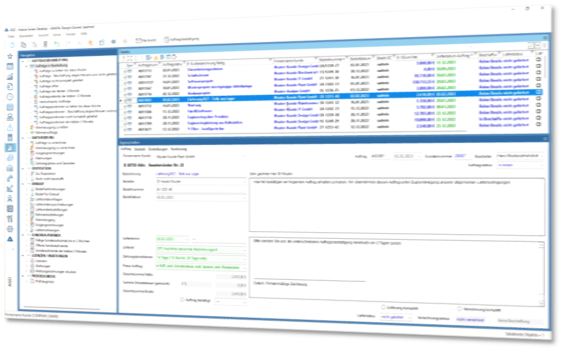
Orders to be processed
Order properties such as delivery date, payment terms, prices, and more.
Overview of all orders
Clear article management
Based on the general article management, the relevant commercial information for order processing and procurement is added.
- Customer and supplier price lists
- Warranty and guarantee information
- Classifications for statistics
- Data for the automatic preliminary account assignment of invoices
Rapid order management
The order is automatically transferred from the last valid offer. All information from the quotation is transferred. Add information to the order, such as the customer's order number, and create an order confirmation. You have an overview of the associated items, orders, deliveries and invoices for the order at all times.
Order data
The order number and the order date are generated automatically. Data such as customer data, delivery address, invoice address or conditions are taken from the customer and can be changed individually in the current order. Text modules are available for the header and footer.
Order confirmation
A report is used to generate a document as PDF or Word document, which is stored in the document management and can be sent to the customer directly from AXAVIA via e-mail.
Order status
The status is determined separately for delivery, billing and payment. It is therefore clear at any time how far the order has been processed.
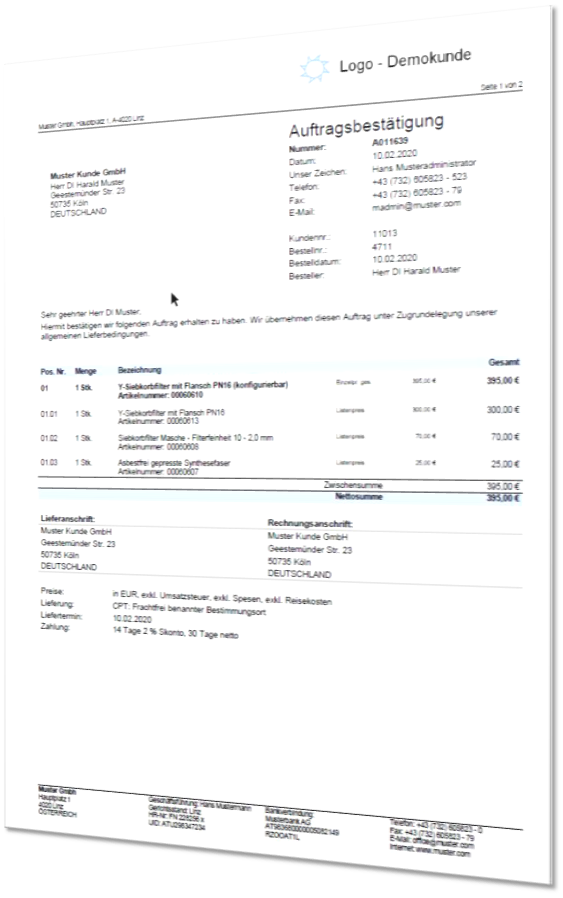
Customizable
Packaging and transport made easy
Appropriate shipping documents are required for the shipment of products. You create the "packing list" and the "transport order" with information on content, weight and size as well as delivery instructions directly in AXAVIA and generate the necessary documents for shipping.
Packing and packing list
A delivery can be grouped into appropriate packaging units. Packing notes provide the packer with the necessary information. The contents of the individual packaging units are listed in a packing list. The corresponding packaging units with dimensions and weight are handed over to the transport company in the form of a packing list. The contents are also used to automatically determine the value that is relevant for taking out transport insurance.
Transport order
In a transport order, the necessary information is transmitted to the transport company.
Invoicing & dunning at the push of a button
AXAVIA supports you in creating invoices. Existing information from previous steps of order processing is seamlessly transferred. For you as a user this means maximum comfort and the greatest possible security for the correctness of the data.
In addition, you can track the invoice status and, if necessary, run your entire dunning process with it.
- Outgoing invoice
- Pro forma invoice, down payment invoice, partial invoice
- Initial account assignment
- Credit note, debit note
Reconciliation from order
An outgoing invoice can be generated by transferring an order. In doing so, the respective positions are selected accordingly and thus taken over in the outgoing invoice.
Reconciliation from time record entries
An output invoice can be created from a transition from one or a series of time recording entries. In this case, the data is transferred from the time recording entries to the output invoice in cumulative form.
The transfer prices are defined manually in the invoice via a product selection or via stored price lists.
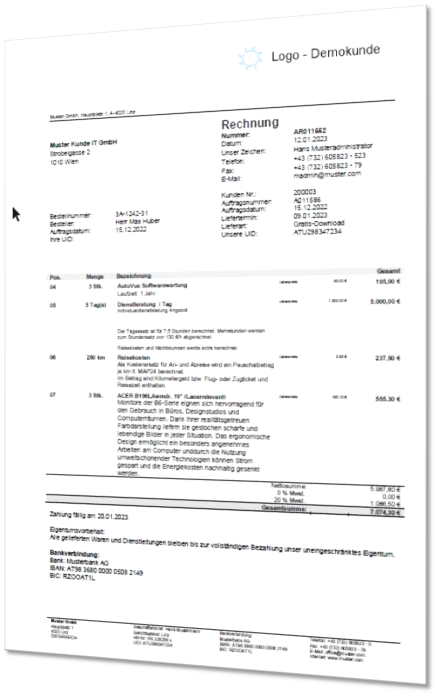
Automated invoice generation
Prices from the stored product catalog
Demand requirements (BANF) - Reduce costs, strengthen competitiveness
A purchase requisition is a request to Purchasing to procure a material or service in a certain quantity by a certain date. A purchase requisition results from a need for goods or services. It is used to initiate a procurement process. The requirement does not represent yet a purchase order. The purchase requisition is created as a requisition note by the relevant department manually or with the appropriate transfer from the bill of materials and forwarded to Purchasing.
In addition to the customer and the project number, the purchase requisition lists the article name and article number, the quantity and the corresponding price, the supplier and the desired delivery date. Depending on the volume of the order, it must be released by the cost center manager in accordance with the respective company guidelines. Based on the purchase requisition, the corresponding procurement is triggered by the purchasing department, which can result in a supplier order, a production order or a stock withdrawal.
If there is a central procurement in a company, the current need is announced to the procurement. Information is given such as product, delivery date or preferred supplier by the requirement carrier. In the procurement the planning for the procurement is settled then and specified whether the demand is covered by purchase, stock withdrawal or also by the own production. The procurement over stock withdrawal and own production are treated in the modules to the camp administration and production planning. The procurement by purchase with supplier inquiry and order is described in the following more exactly.
Automated supplier inquiries & orders
Supplier inquiry
In many cases it is necessary to request current prices. Use the supplier inquiry and quickly and easily create a request to your suppliers and send it by e-mail to quickly receive the desired prices. The supplier inquiry can be transferred from the BANF positions and thus be created easily and quickly. In special cases, it is also necessary to transmit additional documents such as drawings or specifications to the supplier.
You should receive the concrete offer from the supplier, which you can store accordingly in the supplier inquiry. You can enter the offered prices and delivery dates in the items of the supplier inquiry.
in the supplier inquiry. If you need to create several RFQs at once, you can use the supplier RFQ to compare RFQs. Define the items to be requested in the RFQ and create a separate supplier RFQ for each supplier.
Supplier order
Generate your supplier order from the BANF or the inquiry by means of transfer. Add further data such as delivery date, payment terms or other conditions and send the order as a PDF file via e-mail to the supplier. The status of a supplier order is automatically determined via the further process steps such as delivery receipt and invoice receipt or payment. You therefore have a quick overview of the status of your orders at all times and can react quickly in the event of delays.
Post calculation & controlling - all costs at a glance
Order tracking
Order and project controlling are the most essential tasks for project management, purchasing and sales. With AXAVIAorder you have an overview of the order status at any time. Have your orders already arrived? Has your production order already been completed? Which parts were delivered to the construction site and when? Which parts have been invoiced to the customer? You have an answer to these and many more questions at hand at any time.
- Order status
- Delivery status
- Settlement status
- Payment status
Order post costing
All cost and revenue-relevant information is collected for the order and displayed in the final costing. The costs and revenues are determined according to supplier order, incoming delivery, incoming invoice, payment, outgoing delivery, outgoing invoice, travel costs, expenses, transport costs and hourly expenditure, and a yield is calculated for the order.
This simple concurrent post-calculation is a running calculation and is up-to-date immediately after the data is entered and is intended for a quick overview of the order situation.
Project Cost Control
For a detailed cost control according to cost type, cost unit and cost center, the cost and revenue relevant elements are added to the cost elements according to a freely definable structure. The posting is carried out by means of stored rules. The cost control takes place on the one hand project-related and on the other hand company-related. Due to the time-accurate postings, the corresponding cost development is also visible. The comparison between calculation, budget, current situation and extrapolation is also available for cost control.
Accounts payable / accounts receivable management as the cornerstone of successful accounting
Accounts payable and accounts receivable form the basis of all business cases. The accounts contain all relevant information for posting business cases to the customer and supplier.
The accounts receivable and accounts payable are linked to the business partner of the address management and receive the corresponding basic information such as company name or address inherited from there.
Chart of accounts & invoice account assignment as a basis for automated accounting
Chart of accounts
A chart of accounts is a list that systematically assigns all types of costs to numerical accounts for accounting in an industry. It serves as a guideline and recommendation for the preparation of a concrete chart of accounts in a company.
The chart of accounts in AXAVIA is also the basis for the preliminary account assignment of invoices and payments. The individual accounts are structured into corresponding groups. The chart of accounts is defined for the respective company (client) and the respective fiscal year. The individual accounts have information such as account number, description and tax code.
Invoice account assignment
For quick posting of incoming invoices, outgoing invoices and payments, the documents can be pre-assigned. On the one hand, this can be done manually, and on the other hand, posting rules are available for this purpose, which carry out the pre-accounting largely automatically.
For the posting rules information like posting group from the article, country information of the business partner or the type of business case is used. Of course, the posting rules fall back on your defined chart of accounts.
Transparent financial management through cash book
A cash book is required to keep the cash register records. For this purpose, all incoming and outgoing payments are kept with the relevant information. With a report, you print the cash book at the end of the month and thus have the necessary documentation.
Thoughtful budgeting
The budget of a company is the planning for a fiscal year. For this purpose, a budget is prepared for the individual divisions, departments or product groups. These are recorded on a monthly or quarterly basis in order to also show the development of the business over time.
These are then compared with the actual development in order to identify the deviations and to be able to take appropriate countermeasures.
Prevent liquidity bottlenecks and unexpected payment difficulties
Liquidity planning automatically creates a weekly liquidity preview for all companies (clients) from the relevant information. The following data from the ERP is used for this.
- Actual and planned payments
- Invoices with payment terms taking into account discount payers
- Orders with payment plans
- Orders with payment plans
- Special expenses
In combination with the agreed charts of accounts, they have an optimal preview of the available liquidity
of the next months.
Optimize your personnel processes
Employee master data
The master data of the employees is the basis for the personnel management. In addition to basic data such as name, e-mail address or telephone number, personal data such as private address or date of birth can also be stored. The management of the personnel file also includes the contract data such as date of hire, relevant PPA or classification to the PPA. You can also store the signed contracts in the document management and have direct access to the documents at any time.
Qualifications and knowledge
Define your requirement profiles in the form of qualification catalogs and store the respective knowledge with an assessment for each employee. Based on the deposited knowledge and the definition of the qualification of a task AXAVIA Project Management supports you in selecting the most suitable employee.
- Qualification catalog for the respective requirement profiles
- Different qualifications per catalog of requirements
- Rating scale per qualification
- Automatic selection of suitable employees according to qualification in
Project management
Certificate of competence with expiration date
Store the required qualification certificates such as welding certificates or crane operator certificates for each employee. AXAVIA reminds you in time before the validity of the certificates expires.
- Validity over expiration date
- Resubmission before expiry
Digitized applicant management
Recruiting employees is currently of central importance. No company can afford not to consider applicants anymore. Applicant management is therefore a core element of personnel management.
Create your job postings and publish them accordingly via your web page. The applicants can apply for the corresponding advertisements directly via your website and you keep the optimal overview. Integrate the applicant portal directly into your homepage. The applicants can register here for your job postings and you receive the applications digitally in the applicant database. The applicant also saves his application documents simply via the portal into your applicant database.
Use AXAVIA right away for the management of job interviews as well as for the organization of the further application process. In combination with the applicant portal on the web you can completely digitalize the application process.
In combination with the reporting tool AXAVIA provides you with statistics and evaluations of your application process.
Efficiently manage development tasks, licenses and maintenance contracts
Software license management
In many companies, not only hardware components are sold, but also product licenses. Especially in the IT sector the management of product licenses is an important part in order processing. AXAVIA provides you with an overview of which licenses the customer has purchased.
The following data are relevant:
- Software product and license type
- Serial number and unlock code
- Validity period
Software maintenance management
Maintenance contracts are contracts for the provision of ongoing services that are charged periodically. Typical examples are software maintenance, which is charged annually. In customer service it is particularly important to have quick access to the contract data in order to be able to pass on possible additional costs to the customer quickly. Term, billing information and cancellation period are stored in AXAVIA as well as the link to the corresponding invoice. AXAVIA provides you with an overview of all current maintenance contracts at any time and when they expire or have to be charged again. Via service jobs even recurring billing can be automated.
Requirements and development tasks
If you also develop software yourself, the organization of software development is an important success factor. The development task represents an extension of the tasks from the project management. On the one hand, define your requirements and the development tasks derived from them. Plan your sprints from the pool of development tasks and define the sequence of processing. Define the time budget and, with integrated time tracking, monitor adherence to the budget. Document information about testing, documentation and responsibilities in your quality standard.
- Definition of development tasks
- Definition of sprints via task groups
- Set the priority and sequence
- Definition of time budgets
ERP-IT extension on the web
The Web Portal provides your customers with information about licenses and maintenance contracts. Use the Web Portal in your projects and organize your project requests via the Web Portal. In combination with the ticket system, you have a comprehensive communication platform with your customers.
- Project requirements
- Software licenses
- Software maintenance
